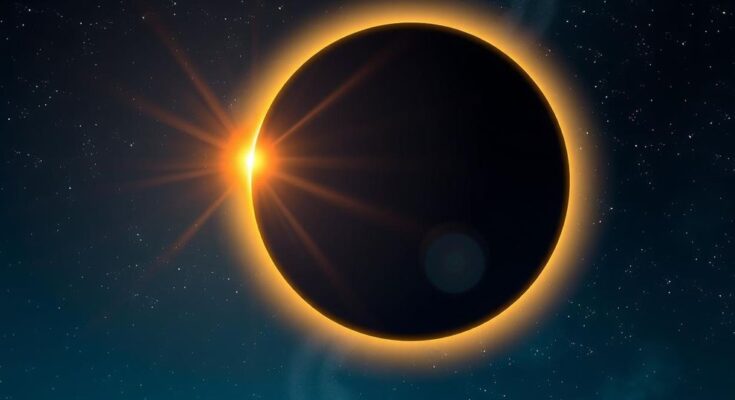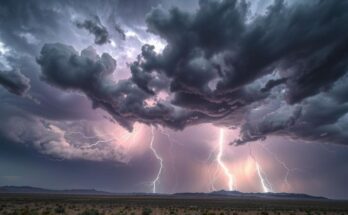The first solar eclipse of 2025 will occur on March 29, visible from parts of the USA, Canada, South America, and Europe, but not in India. This partial eclipse will last approximately four hours, with safety measures recommended for viewing. Unique phenomena such as double sunrise will be observed in certain regions.
The first solar eclipse of 2025 is set to take place on March 29, marking a significant celestial event termed ‘Surya Grahan’ in India. During this occurrence, the Moon will partially obscure the Sun. This partial eclipse will be observable from various locations worldwide, including regions in the USA, Canada, South America, Iceland, Greenland, Europe, and Northern Asia, though it will not be visible in India.
This solar eclipse will occur during different times globally. Some countries will experience the eclipse at sunrise, while others will observe it in the afternoon. This event will also create a phenomenon known as double sunrise in certain regions, where the Sun appears to rise twice due to the eclipse’s unique visual effects.
In the UK, the visibility of the eclipse will vary, with north-west Scotland experiencing the highest coverage of 47.9%, particularly at Gallan Head. Conversely, Dover will see the least visibility, with only 28.1% of the Sun obscured, while Manchester is expected to have a 36.1% coverage.
To ensure safety while observing the solar eclipse, individuals should check their eclipse glasses for any damage. Supervision is necessary for children using eclipse glasses. It is crucial to avoid using eclipse glasses with telescopes or cameras, as this can lead to serious eye injuries.
For safe viewing, individuals should utilize certified solar viewing glasses or handheld solar viewers. Regular sunglasses, regardless of their tint, are insufficient for viewing a solar eclipse. Alternatively, indirect viewing methods such as a pinhole projector can be employed to observe the eclipse.
Additionally, Google has created an engaging feature for this celestial event. Users can search for ‘solar eclipse’ or ‘surya grahan’ to witness an animation depicting the eclipse’s visual progression.
Directly looking at the Sun during the eclipse is not advisable, as it poses serious risks to eye health. Certified eclipse viewing tools must be used at all times, per NASA’s recommendations. Regular sunglasses will not provide adequate protection.
The timing of the solar eclipse will differ globally; for example, in the northeastern United States, the eclipse will unfold during sunrise. In addition, it will begin in mid- to late morning in western Europe and end in the afternoon in eastern Europe and northern Asia.
The solar eclipse will primarily be visible in North and South America, Europe, Africa, and parts of Greenland and Iceland, while major Atlantic and Arctic ocean areas will also witness this astronomical event. Unfortunately, India will not be able to view this eclipse.
A remarkable aspect of this solar eclipse is the double sunrise phenomenon, which will occur in specific parts of the USA and Canada, resulting in the Sun seemingly rising twice due to the Moon’s shadow.
According to Indian Standard Time (IST), the solar eclipse will commence at 2:20 PM, peak at 4:17 PM, and conclude at 6:13 PM, lasting approximately four hours.
The solar eclipse on March 29, 2025, represents a significant astronomical occurrence, notable for its visibility across various global locations. Key regions such as the USA, Canada, and Europe will experience varying degrees of obscuration. Safety measures while viewing are paramount, and specialized solar glasses or viewers are essential to prevent eye damage. Additionally, this event introduces interesting phenomena, such as double sunrise, adding to the uniqueness of the celestial display.
Original Source: www.hindustantimes.com




